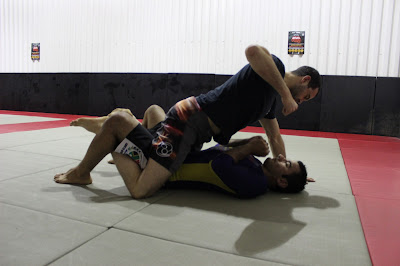Escaping the Mount. Rules vs Principles
Being at the bottom of the mount is a bad day at the office,
irrespective of whether we're talking BJJ, no-gi submission wrestling, MMA or
of course genuine self-defence. The physical elements (gravity, friction, reach,
visibility, breathing and absorption to name a few) are not in your favour and
neither are the psychological ones (claustrophobia, fear, uncertainty, anxiety
and slowed reaction time). Whether you're worried about strikes raining on your
head (MMA / self defence) or getting caught in a choke or a joint lock (BJJ /
submission wrestling) some principles remain the same when addressing mount
escapes:
As you
can see the preparation is identical and the principles are maintained (both
players are controlling the distance, but in different ways).
- Never
allow the opponent to get fully settled on top of you.
- Seek
to control the relative distance between your hips and their hips.
- Read
and manipulate their weight distribution.
- Utilise
cumulative advantages. In other words every inch you gain from them is
yours and you shall never give that back to them.
To demonstrate these principles, let's look at a fundamental
escape technique (the elbow-knee) and see how the principles stay the same
while circumstances dictate their expression. For the sake of this discussion,
we will look at both the preparation stage of the technique and its execution.
The Preparation Stage:
Brazilian Jiu Jitsu (and indeed all grappling) is an art.
What this means is that we are constantly striving to be more efficient and
fluid in out execution and nothing increases your efficiency than arriving
prepared for the technique.
 |
| Picture 1 |
In the first picture, your opponent (person on top) has deep
control over your lower body which in turn frees him to posture up, land his
strikes, set up submissions or simply tire you out by posting against your
thrashing attempts to throw him off. Never allow your opponent to get settled
and attached like this in the mount.
 |
| Picture 2 |
In picture 2 you can see that even though the opponent is
mounting on you they don't exert as much control and are constantly worried
about their base. The player on the bottom realises the value of blocking the
feet from hooking under the body/legs and anchoring. Their left elbow and knee
are glued to the mat (hence the name of the technique).
The Technique Execution:
The above is an excellent example of how the principles that
govern your lower body actions remain the same in BJJ, submission grappling,
MMA or indeed self-defence. Never let your opponent settle on you.
Above you can see the execution of an
elbow-knee escape where the player on the bottom is not worried about the
opponent suddenly posturing up to strike so he uses his forearm as a wedge
under the body to keep the weight off him.
In picture 3, however, the arm is used more to control the top player's posture in fear of them posturing suddenly for a few punches.
 |
| Picture 3 |
It is important to understand your actions in these
situations but more importantly the concepts and principles that lie behind
these actions. Advanced practitioners will be able to bend (or even break) the
rules (but that’s only because they fully understand the
principles behind them. Until you reach that level of automation, devote your
time to fundamental principles and watch your progress skyrocket!
I'd like to thank my friend and coach Martyn Cahill, BJJ black belt and head instructor at Fighting Fit Martial Arts, and the THLL production team for their assistance in this article.
Comments
Post a Comment